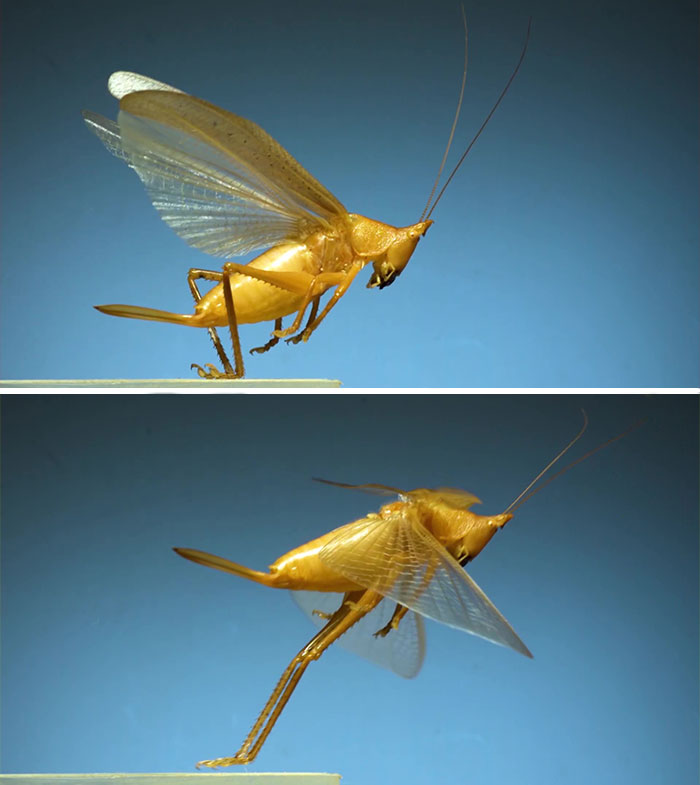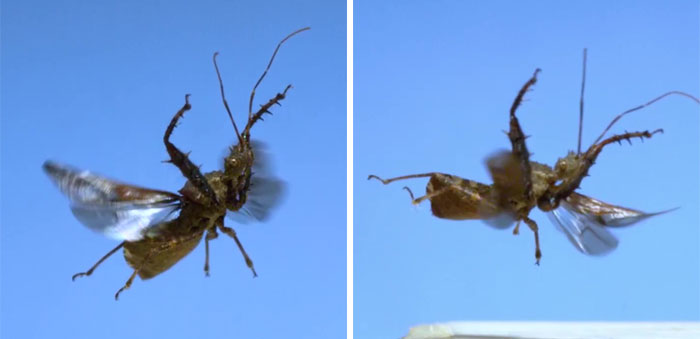
Here’s What These 11 Insect Species Look Like Flying In Slow Motion And Some Of Them Look Hilariously Derpy
Yeah, sure, bugs are gross, especially if there are one or more phobias in the mix, but bugs can also be very, very cool. You know, like the very colorful ones. And ones that get zoomed in very close on a camera. And also the ones that are also captured in ultra slow motion. Yeah, you know where we’re going with this.
Ant Lab, a YouTube channel headed by research biologist Dr. Adrian Smith, has recently released a pretty cool video showcasing 11 kinds of winged insect species taking off in super slow motion. Oddly satisfying and hella interesting, to say the least.
Everything in slow motion is better—even winged insect take-off and flight
Image credits: Ant Lab
So, Ant Lab is a YouTube channel of the Evolutionary Biology & Behavior Research Lab at the North Carolina Museum of Natural Sciences & North Carolina State University. It is hosted by Dr. Adrian Smith, a research biologist interested in animal behavior and communication. Bored Panda got in touch with Dr. Smith for an interview.
One of the channel’s most recent videos takes a look at insects in flight. In particular, it features 11 different species across 5 taxonomic orders of winged insects taking off in ultra slow motion—3,200 frames per second. Among the many insects, there are various species of weevils, katydids, and barklice, and it also features an insect with a very badass name—the spined assassin bug. The insects were collected between July and November in Raleigh, North Carolina, save for the bush katydid, which comes from New Hampshire.
And Dr. Adrian Smith of Ant Lab has given us a unique glimpse at just how awesome bug flight is using slow motion cameras in one of his most recent videos
“The YouTube channel grew out of my research and my interest in video-making,” explained Dr. Smith the origins of how he got into doing YouTube videos. “I specialize in studying insect behavior. A lot of that research involves capturing what an insect is doing on video. So, I learned macro photography and videography out of needing to do it for research.”
“At the same time, I am and was a fan of internet/YouTube media, so I also started trying to figure out how I could make meaningful content with my science. While I was a graduate student, I took a night class in media production at a local community college which had a film program and that opened the door the basics of editing and I was off and running.”
“Now, with the Ant Lab channel, the videos I put there are tied to my research interests. I go out and try to capture insect stuff on video that no one has yet. It’s interesting to me, for research purposes, to see if there is something I could study. At the same time, I try to capture the visuals in a way that they can be appealing and serve a narrative for a YouTube video. The best thing is when something makes a nice YouTube video and, eventually, a nice peer-reviewed scientific publication!”
The videos of bugs taking off were captured using an ultra slow-mo camera at 3,200 frames per second
Image credits: Ant Lab
Now, we’re used to seeing bugs as a blur when they are in flight—unless they are slow fliers—but the video provides a unique and detailed glimpse at how insects take off and fly. And some look super graceful and structured in how they fly, while others are derpy and you can’t help but love it.
Weevils, for instance, look like they are trying very hard to take off, with their extremities comically extended in random directions as if flying for the first time, hoping for the best. Katydids, however, are much more structured and graceful in how they fly: they have these long hind legs that help them kick off, timing the jump with the first flap of the wings. The march fly is another specimen that looks like it’s trying to break dance mid flight, doing the superman along the way, but it looks cool regardless!
We asked Dr. Smith to explain why each insect has a different aptitude when it comes to flying. He had this to say: “Flying ability is an evolutionary trait, just like any other thing. For some insects, being a strong flyer is beneficial or even crucial for their lifestyle. For others, flying is just an occasional, once and a while thing they do. They don’t have to be good at it, just good enough.”
“Insects fill a lot of ecological roles and are adapted to living in an astounding variety of ways. You can see that even in these flight videos. Variable things like number of functional wings, wing beat frequency, quickness to take off, the role of jumping all are likely to have explanations that relate to how the insect makes a living or even keeps on living (avoiding predators) in the world.”
While some insects look majestic, showing masterful coordination and grace…
Image credits: Ant Lab
This is one of two videos available on the channel. The previous video features a handful of other insects, like the firefly, the scorpionfly, the lacewing, and my personal favorite—the rosy maple moth. Just look at it, it is absolutely poofy and adorable.
“[The videos] were shot either in my in-law’s basement or in my laundry room, thanks to working from home,” explained Dr. Smith. “All the insects in them were caught, basically, in my backyard either by hand or through setting up a blacklight at night to attract them. One of the things I wanted to do with these videos is demonstrate how astounding insects right outside your door can be!”
He continued: “To film them, I catch them in a small vial and then release them on a 6cm x 2cm acrylic platform. All of the shots in those videos are filmed at 3,200fps or more, so the lighting is key and suuuuuper bright. The insects’ response to the light is usually to avoid it, so flicking it on usually triggers the flight behavior I am looking to capture.”
“If the footage I get is notable, I’ll keep the specimen for further study, otherwise after filming the insects go back outside. They usually don’t fly far and I can re-catch them to film multiple sequences. A few of them did escape and are probably still wandering around my laundry room/house.”
… others are a tad bit derpy and look like even they’re surprised that they’re flying
Image credits: Ant Lab
And making these videos isn’t all that easy, as explained Dr. Smith. “Macro videography with insects is difficult because of small size and their quickness. Maintaining focus, framing the subject, lighting the subject, and managing the subject’s behavior all make it difficult. For every insect that is in these videos, there’s another species that I tried to capture flying, but failed.”
The video has received quite a bit of attention, garnering over 335,000 views and being discussed in online news media. Among all of the appreciation in the comment section, there were also many who joked about all of the insects looking like they are surprised they can fly.
Others poked fun at how it actually looks awesome in slow motion, but in reality, we’d all be going for a fly swatter or calling the exorcist if it’s a bigger bug. A number of people even pointed out that the weevil is their spirit animal because of how derpy it is.
Image credits: Ant Lab
“When I made the videos and did some background research reading for them, one thing I really came to better appreciate was that insects did it first!” concluded Dr. Smith. “Before I made these videos, I think I first related the concept of ‘flying animal’ to a bird or maybe a bat. Maybe because those things are more on our scale and obvious. But, the thing is that insects were the first animals to fly and they still are the most numerous and most varied flying machines on earth! Flying is much more of an insect thing than it is a thing for birds, bats, airplanes, or drones! My perspective has changed and I am continually astounded by how much we still have to learn or even just document with the insects all around us.”
You can check out more on the Ant Lab YouTube channel—it’s full of insecty goodness, and you can also check out Dr. Smith’s website or any of his social media: Twitter and Instagram. But before you go, what are your thoughts on this? Which one of these is your favorite? Let us know in the comment section below!
There’s also another video from August showing off a handful of other insects in flight
Image credits: Ant Lab
12Kviews
Share on FacebookOkay, coming from someone who really does not like bugs: that was amazing!
Okay, coming from someone who really does not like bugs: that was amazing!

 Dark Mode
Dark Mode 

 No fees, cancel anytime
No fees, cancel anytime 



























































62
4